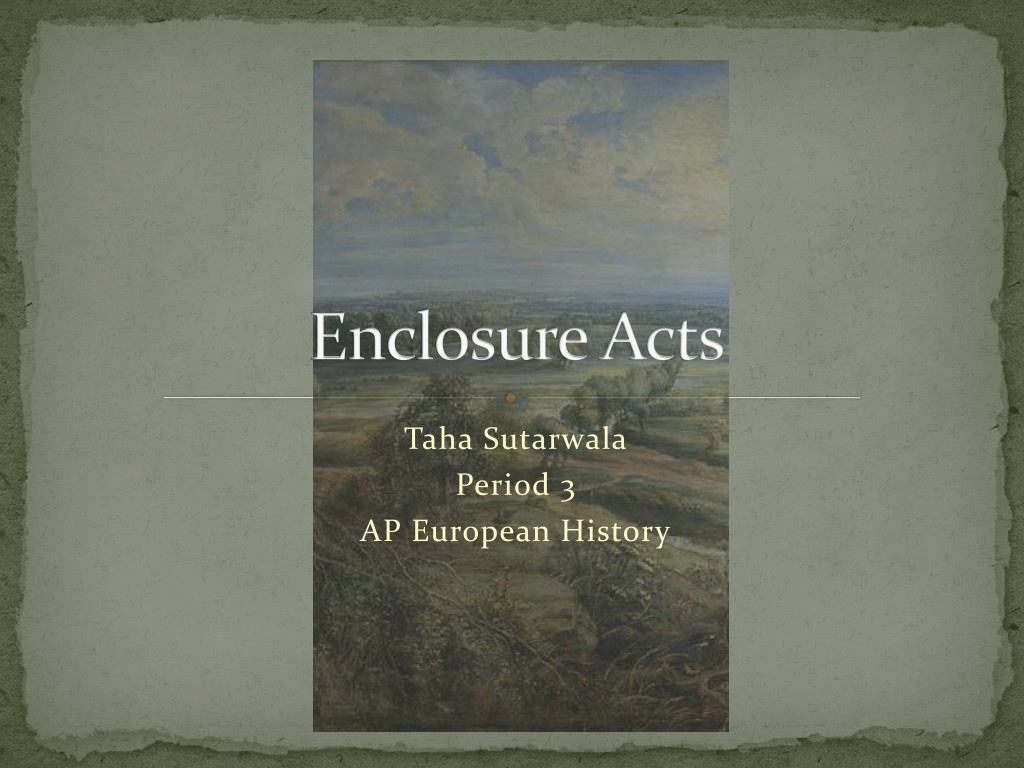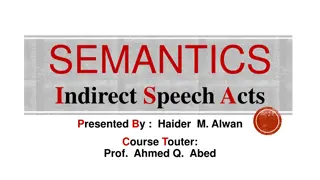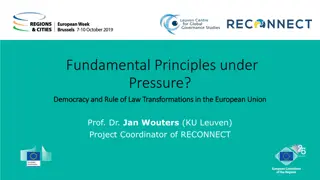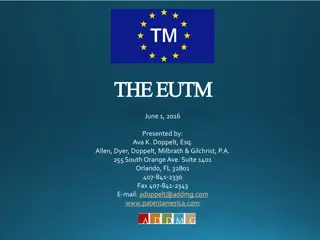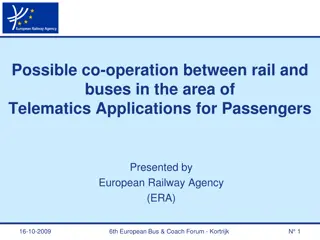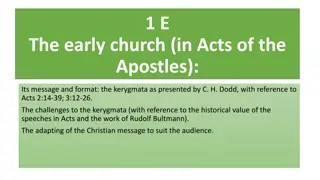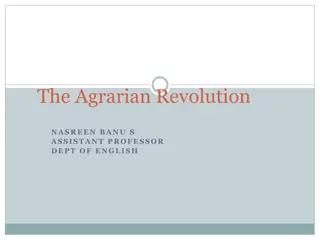Impact of Enclosure Acts on European History
Enclosure Acts in the United Kingdom led to the privatization of common land, marking a significant shift in English agriculture and society. Large-scale farmers and aristocrats capitalized on consolidation, leading to the loss of land for small farmers and disruption of the traditional agrarian way of life. The Enclosure Acts boosted agricultural profitability but deepened the divide between the wealthy and the disadvantaged, altering the landscape and social structure of England.
Download Presentation

Please find below an Image/Link to download the presentation.
The content on the website is provided AS IS for your information and personal use only. It may not be sold, licensed, or shared on other websites without obtaining consent from the author.If you encounter any issues during the download, it is possible that the publisher has removed the file from their server.
You are allowed to download the files provided on this website for personal or commercial use, subject to the condition that they are used lawfully. All files are the property of their respective owners.
The content on the website is provided AS IS for your information and personal use only. It may not be sold, licensed, or shared on other websites without obtaining consent from the author.
E N D
Presentation Transcript
Enclosure Acts Taha Sutarwala Period 3 AP European History
History of Enclosures Enclosure acts were a series of United Kingdom Parliament Acts, which enclosed open fields and common land in the country, creating legal property rights that was previously considered common. Between 1604 and 1914, over 5,200 individual enclosure acts were put into place, enclosing 6.8 million acres of land. The Enclosure Acts stole the people s land, impoverished small farmers, and destroyed the agrarian way of life that had sustained families and villages for centuries For centuries, English agriculture depended on common land land that was privately owned but to which others enjoyed the legal right of access (the term commoner originally meant someone who had access to common land). Waste land was also accessible to local inhabitants. Small-scale agriculture could be arduous and unpredictable, but life organized around the commons was relatively democratic, egalitarian, and self-sustaining
History of Enclosures (cont.) Although the enclosure of common land had been taking place since the time of the Tudors, advances in agriculture in the eighteenth century made consolidation of land profitable, inciting large-scale farmers and estate owners to claim more and more land. There was a rapid increase of enclosure between approximately 1750 to 1850. Before there were only private acts, but then Parliament stepped in and passed about 4,000 acts during this period. Virtually no common land was left. Not only did the Enclosure Acts contribute to an economically to Britian, they also redefined the land and its relationship to the people. The destruction of common land was a devastating blow to small farmers and the poor. But they also increased the profitability of agriculture http://www.thelandmagazine.org.uk/articles/short-history-enclosure- britain
History of Enclosures (cont.) A map of a possible enclosure located in this document http://assets.cambridge.org/97805218/27713/excerpt/9780521827713_excerpt.pdf The following is an example of what a Parliamentary enclosure act might look like:
Why Enclosures? Government and aristocracy started enclosing land, as it would allow for better raising of crops and animals. Large fields could be farmed more efficiently than smaller plots of land Profit could be kept by the aristocrats Beginning of commercial farming Began because of rising prices of wool and grain Needed to keep food production up with growing population http://socserv2.socsci.mcmaster.ca/econ/ugcm/3ll3/bradley/Enclosure .pdf http://assets.cambridge.org/97805218/27713/excerpt/9780521827713_ex cerpt.pdf
Effects of Enclosures In England, open fields were enclosed fairly but other historians argue that because large landowners controlled Parliament, which made laws, they had Parliament pass hundreds of enclosure acts each that authorized the fencing of open fields in a given village and the division of the common in proportion to one s property in the fields The heavy costs of enclosure were also divided among the people, peasants had pay cost and landless cottagers lost access to common pastures By 1750, as much as half of English farmland was enclosed and many English lost their ability to produce wool, from sheep, for the growing textile industry. http://www.youtube.com/watch?v=YhZ7UruxRBs
Effects of Enclosures (cont.) By 1700, a highly distinctive pattern of landownership and production existed in England, there were the few large landowners on one side, and at the other extreme were a large mass of landless cottagers who labored mainly for wages, and in between, small, independent peasant farmers who owned their own land and substantial tenant farmers who rented land from landowners, hired laborers, and sold output on market. The tenant framers, who had formerly been independent owners, were the key to mastering the new methods of farming, because the tenant farmers fenced fields, built drains, and improved the soil with fertilizers increasing employment opportunities By eliminating common rights and greatly reducing access to land, the enclosure movement marked the completion of two major historical developments in England The rise of the market-oriented estate agriculture The emergence of a landless rural proletariat wealthy English land owners held most of the land, leasing their holdings to middle-sized farmers, who in turn relied on landless laborers for their workforce (proletarianization this transformation of large numbers of small peasant farmers into landless rural wage earners)
Effects of Enclosures (cont.) Some farmers gained from enclosing More productive ways of farming were developed. Farms that were small and practically unprofitable came into the market. Some farmers whose farms had been yielding no profits, were able to work on large farms to support their families. There was a general increase in food being produced. They improved the health of the general population, especially of those who lived in towns and cities. Certain landowners in the 1830's, like Charles Townsend, showed that by enclosing land into large compact blocks, instead of scattered strips, saved time while farming and also avoided wasting land between strips. New and larger farming machinery, such as the seed drill, became more useful with enclosure. Also, experimental methods such as "four- field" crop rotation could be used more effectively.
Social Effects of Enclosures Farmers lost their farms of jobs and migrated to cities to find work. Enclosures caused poverty, homelessness, and rural depopulation, and resulted in revolts in 1549 and 1607. The image of a happy, prosperous village was an idealized vision of England itself, in which the people were industrious, independent farmers with ties to specific plots of land going back through generations. With the rise of large-scale agriculture and the removal of small farmers from land that had historically been theirs to use, this image became increasingly difficult to sustain. While commons were often consolidated into larger agricultural units, some of the land was annexed to estates for show, creating broad vistas and carefully designed wild areas. turned farmland into landscape, eliminating its use value and redefining it as an aesthetic resource that signified the wealth and taste of landowners. No longer the foundation for an agrarian England, land became the exclusive cultural capital of the elite.
Social Effects of Enclosures (cont.) Historians J.L. and Barbara Hammond in The Village Labourer 1760 1832 (1911) describe the workers who were driven into factories by the Enclosure Acts: The enclosures created a new organization of classes. The peasant with rights and a status, with a share in the fortunes and government of his village, standing in rags, but standing on his feet, makes way for the labourer with no corporate rights to defend, no corporate power to invoke, no property to cherish, no ambition to pursue, bent beneath the fear of his masters, and the weight of a future without hope. No class in the world has so beaten and crouching a history. http://archive.org/stream/villagelabournew00hammuoft/villagelabour new00hammuoft_djvu.txt The enclosures created a veritable army of industrial reserve labor. The displaced and disenfranchised were reduced to working for starvation wages that they supplemented through prostitution, theft, and other stigmatized or illegal means.
SELECTED IMPACTS OF THE ENCLOSURE ACTS Positive Effects Less land wastage boundaries between strips could now be farmed Land of a good farmer no longer suffered from neglect of neighboring strips Animal diseases were less likely to spread to all village animals. Separate fields for animals made selective breeding possible Negative Effects Eviction of farmers (known as customary tenants) who failed to prove legal entitlement to land their families had worked for generations Poor farmers, allocated small plots of land, were unable to compete with large landowners. Many lost their land when their businesses failed
Enclosures and the Industrial Revolution Due toenclosure acts people living in the countryside found themselves without a way to support their families, they were forced off the farm. By the landed aristocracy forced. (Because, as stated above, they were the ones that actually owned the majority of the land, and the social classes are highly stratified at this time in Great Britain.) New technology and advanced cropping systems replaced many laborers. Moving to the cities, they found work in factories. The jobless poor would end up as constituting the working class in the Industrial Revolution that would follow shortly. It gave individuals more profit to invest in the new industries, and forced previously farming families to move into the cities and work in the factories. In the factories and mines, workers were paid low wages, and that formed the Middle Class http://www.youtube.com/watch?v=l0nM5DU4ADI
Enclosures and Urbanization Enclosure by the landed gentry restricted use of what had been "common land" - able to be used by all in the area. This loss of land availability diminished the ability of the small farmers to survive. Left without a way to make a living, farmers and agricultural workers moved to cities to try and find work. 1700 - With the exception of Holland, at least 80 percent of the people of all western European countries drew their livelihoods from agriculture (Eastern higher percent) Towns grew very rapidly in size Whilst it is estimated that in 1700 17% of the population resided in urban areas, this figure had risen to 25.5% by 1800 and by the turn of the 20th century had reached 77%. The urbanization of the English population was largely fueled by dispossessed peasants who moved to the city in the hopes of finding new work
Reactions to Enclosures Riots In 1607, beginning on May Eve in Haselbech, Northamptonshire and spreading to Warwickshire and Leicestershire throughout May, riots took place as a protest against the enclosure of common land. Now known as the Midland Revolt, it was led by John Reynolds, who said he would protect the rioters. http://www.jstor.org/discover/10.2307/3678075?uid=3739560&uid=2129&uid=2&ui d=70&uid=4&uid=3739256&sid=21103804864353 The Newtonian Rebellion occurred on June 8, 1607. Over a thousand gathered at Newton, pulling down hedges and filling ditches, to protest against the enclosures of Thomas Tresham. James I issued a Proclamation and ordered his Deputy Lieutenants in Northamptonshire to put down the riots. The local armed bands and militia refused the call-up, so the landowners were forced to use their own servants to suppress the rioters on 8 June 1607. The Royal Proclamation was read twice. The rioters continued in their actions, although at the second reading some ran away. The gentry and their forces charged. A pitched battle ensued. 40 50 were killed and the ringleaders were hanged and quartered. King James I then issued a proclamation on June 28, 1607 saying the government would further look into enclosures and the discontent they caused in order to quell these rebellions.
Reaction to Enclosures Most of the English detested the enclosure movement and the great rural depopulation it caused. Oliver Goldsmith in his The Deserted Village condemns rural depopulation and writes: The man of wealth and pride/Takes up a space that many poor supplied; the enclosure acts are only benefitting the wealthy not the poorer folk. http://www.english.upenn.edu/~mgamer/Etexts/goldsmith Thomas More in Utopia also condemns enclosures (the most celebrated denunciation of enclosures) Your shepe consume, destroye, and devoure whole fields, howses and cities . . . Noble man andgentleman, yea and certeyn Abbottes leave no ground for tillage, thei inclose all into pastures;
The End of Enclosures The enclosure movement was brought to an end when it started to upset the middle classes. By the 1860s, influential city-dwellers noticed that areas for recreation were getting thin on the ground. The agricultural depression that by 1875 was well established, improvement was no longer a priority, and in the last 25 years of the 19th century only a handful of parliamentary enclosures took place.
Works Cited Bradley, Harriett. The Enclosures in England; an Economic Reconstruction. New York: Columbia University;, 1918. Print. "Chapter 19: The Expansion of Europe in the Eighteenth Century." AP Study Notes. N.p., n.d. Web. 19 Mar. 2014. "Enclosure Movement." Conservapedia. N.p., n.d. Web. 19 Mar. 2014. "Enclosure Movement (Industrial Revolution)." ISS World History Forum. N.p., n.d. Web. 19 Mar. 2014. "Enclosure Movement." Needham. N.p., n.d. Web. 19 Mar. 2014.
"The Enclosure Movement." The Community Environmental Legal Defense Fund. N.p., n.d. Web. 19 Mar. 2014. Farlie, Simon. "A Short History of Enclosure in Britain." THE LAND. N.p., 2009. Web. 19 Mar. 2014. Goldsmith, Oliver. "The Deserted Village. English.upenn. N.p., n.d. Web. 19 Mar. 2014. "Inclosure Act 1845." Legislation.gov.uk. N.p., n.d. Web. 13 Mar. 2014. Kain, Roger, John Chapman, and Richard Oliver. "The Enclosure Movement in England and Wales." Cambridge University Press. N.p., n.d. Web. 13 Mar. 2014.
McElroy, Wendy. "The Enclosure Acts and the Industrial Revolution." The Future of Freedom Foundation. N.p., 8 Mar. 2012. Web. 19 Mar. 2014. Rosenman, Ellen. "On Enclosure Acts and the Commons." BRANCH. N.p., n.d. Web. 13 Mar. 2014. Slater, Gilbert. The English Peasantry and the Enclosure of Common Fields. New York: A.M. Kelley, 1968. Print. Young, Arthur. A Six Months Tour Through the North of England. N.p.: n.p., 1770. Print.
